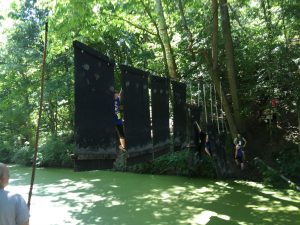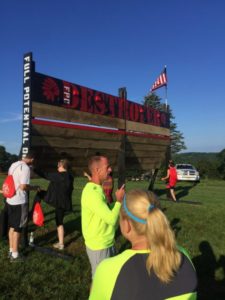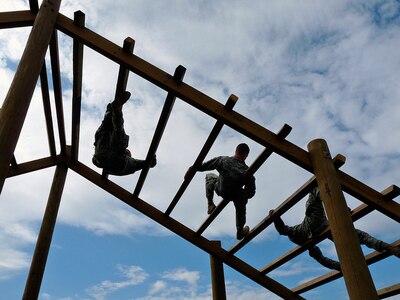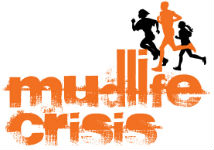Two days ago, I did something I haven’t done before: completed my second OCR in less than a month. Usually I have more time off between my races (my next one, for example, isn’t until the end of July and the 2017 Mud Ninja race), but this time I had the opportunity to run my first Tough Mudder earlier in June so I did. And the race in question was the Indian Mud Run 2017 event!
As you may remember, I ran this one last year for the first time and was blown away by just how awesome it was. This year’s iteration was also fantastic and one of the biggest challenges I’ve had in my OCR career thus far.

The 2016 version of the “Hanging Walls” obstacle. So popular it made it to OCRWC last year!
The organizers added a 10K-plus length race with more obstacles this year (the 5K race was still an option as well). This was the race that was going to be the decider for what I consider one of the bigger coups for the Indian Mud Run 2017: it’s now an OCR World Championship qualifier course. Many folks know that the Hanging Walls obstacle that was such a hit last year was brought up to the OCRWC course in Canada and was raved about there.
I would assume (not knowing for sure, mind you) that this was one of the reasons that the IMR was added as a qualifier this year. It added a really neat sense of competition to the race that I hadn’t seen before. More on that later.
Registration and Pre-Race:
Leading up to the race, I was getting a little antsy because I hadn’t heard anything much from about a week out. But the “Final Instructions” email came on the 20th (the race was the 24th) and all was well – questions were answered, the new directions map was released, scoring/placing was explained, and the prerequisite “what to bring” list was disseminated. All was well in OCR land at that point. Another “the race is tomorrow” message came on Friday – probably to talk about questions that had come up.
Getting to the race from Columbus was easy as pie. Though parking costs had doubled from last year to $10, this is a race that doesn’t have a lot of hidden extra costs anyway so that wasn’t a big deal to me. And they added a shuttle system to get folks from the parking lot to the race village/starting area, so that was a nice touch.
The race village/starting area was not in the same area as last year, I’m assuming due to the addition of a longer race than last year. Registration/packet pick-up and gear check were all in the same building, which was a nice touch and made for easy getting around at the race village.
I picked up my packet with t-shirt and stylish IMR string backpack (last year’s was black, this year’s was red) and headed out to take a look around.
The course, as I said, had been lengthened for the 6.6-mile “Chief’s Challenge” race, and the race village was now in what appeared to be an old golf course area. The Start and Finish lines were right in the same area, which made for better viewing for the spectators. This is a race that was hard to spectate last year due to most of the race taking place in some very challenging terrain in the woods, so it was nice to see that there was a bit more opportunity for fans to come and see the fun. There were at least ten obstacles within a quarter mile walk of the race village, and they were some of the more fun ones to watch (rigs, rope climbs, warped-walls, slides, and the two headline obstacles of the race that I will get to in a moment).
There was also a kids course which everyone could see from the top of a hill – the kids were obviously having fun with that one.

Larry Cooper telling people about his creation – the simple but never easy Destroyer!
I was expecting to see a friend of mine from online there, but he was in a later wave than I so I didn’t have a chance to run into him till later. But I did have the opportunity to finally meet and to talk to Larry Cooper of Full Potential Obstacles, the creator of the famous “Destroyer” obstacle! Larry and his wife were showing off their creation and telling folks about it, and I was pleased that he recognized me from our online presences. It turned out Larry’s wife Ginger is a Columbus-area native and was pleased to be back near her old stomping grounds.
Larry’s got such an amazing passion for our sport and especially for the small races, like the ones I love as well. No matter how many Spartan, Tough Mudder, Warrior Dash, etc. races I do, the ones I seem to enjoy the most are the local ones that pop up once a year or so and just put their all into putting on a great event that people want to come back for. Mud Ninja is one of these for me, and so is the Indian Mud Run at this point.
And he’s also a beast, let me tell you. He was demonstrating the “#noblocks” challenge for racers all day – wherein one ascends the Destroyer without the use of any of the blocks he has on the obstacle. Larry hands out wristbands for the folks who complete his challenge, adding a little something extra to the races he shows off his baby at.
The Hanging Walls obstacle had been added to as well. First, it was no longer over water (a net caught people who fell, now). Second, it had been moved to the final obstacle of the race, right before the finish line (and just after the Destroyer). And third… there was now a cargo net halfway across it that you had to climb under to get to the last few doors. And finally, instead of the first few doors leading up to the four at the top that were side-by-side, it was reversed now: the four doors on the same level were now at the beginning, and the ascending set were at the second half (after the cargo net). Brutal.
At the starting line, the famous Coach Pain was motivating people and getting them ready to take off on the journey. Some people just have a knack for sharing life and pulling people along with them, and Coach Pain is one of those people. He had a special speech for each wave, not just repeating a schtick from one wave to another – and you could tell he really appreciates OCR people for their ability to overcome and triumph. Having him at the event was pretty amazing.
Race Course:
The course itself was right in keeping with the course from last year: that is to say it was an amazing use of the natural terrain and a nearly constant state of climbing and descending. Add to that the doubling of the distance, and this was now a course that was designed to break you.
Because of the heavy rain that the Coschocton area had received the day before the race, though, the course was much more muddy than last year, and that made for a couple of place where you really had to slow down and watch your step, even in the early waves (I ran at 9:00). At one point I slipped out and almost went over a small overhang before grabbing a small tree to stop myself. That was a bit unnerving.
Also, the one complaint I have was that there were a few places that really could have used some better marking. For the most part, the course was well marked with orange tape, orange sticks and arrow signs, and more. But, I don’t know if the rain caused signage to be washed away before the morning of the race or what, but I came across a couple times when people took wrong turns and ended up adding to their course significantly or having to backtrack to find the right turn. I also ran into a case where a guy cut off probably a mile of the course because of some bad marking at a place where the course crossed itself. I myself had a couple places where I had to stop and look around a bit before deciding on a route to continue on. Luckily I chose correctly each time, but the terrain made it difficult to see where the next orange tape might be at times. There were only two or three places where this was an issue, don’t get me wrong, but the point needs to be made.
There were water stops every two miles (so three in total) – and they were handing out small 8-oz. bottles that were easy to carry with you, so hydration was not a problem. Also, I discovered another use for my compression shorts as I was able to tuck one onto my hip for the road.
Obstacles:
Wow. You could really tell that this course was made to test people properly as they attempted to qualify for the OCRWC, because there were a number of heavy duty obstacles added to it this year. There were more rigs, two warped walls, a rope climb, a weaver over water, another slide, and a couple of short swims added to the mix this year – most of these were at the end of the race (say… last half-mile or so). This was on the golf-course section of the course where spectators could really get out and watch better.
And that’s not to imply that they’d changed the obstacles wholesale, don’t get that impression. The rock-wall-based obstacles were still just as prevalent throughout the course. You still climbed up rivers, and crossed cargo nets over ravines, and traversed walls with logs hanging against them, and the like.
Again, the only crawling obstacle was a drainage pipe crawl, which I found interesting in an OCR world where obstacles seem to be mixed between crawls and climbs.
The first rig had four gymnastics rings to swing between, and then a short big of cargo net to go under. There were a couple more rings after that, and then a hanging “shark cage” type contraption that you had to climb under and then up through the middle of. A pole hang was after that. It was a good challenge and I want to say it was about two miles in or so.

Not the Weaver at Indian Mud Run, but this should help you visualize how it works.
The weaver was another good one, and a bit nostalgic for me as the last time I did one of those was at one of my ROTC camps in college. You’ve seen the big ladders with the rungs about three feet apart at plenty of races, probably. Well, now imagine an a-frame made of these – and you don’t just climb up and over, you have to weave over and under the rungs. So it’s a real test of your whole body as you have to support yourself from falling off.
A couple of the obstacles that had been along the canal near the park had been moved out to the golf course area, as I said – one of those was the Dragon’s Back obstacle.

The “Dragon’s Back” obstacle. Not hard to do, but hard to get past the fear factor!
This is one that I really like. The Dragon’s back is simply a jump/leap of faith type situation where you have to leap across a gap and grab a bar, then pull yourself up to do it again. The IMR version had two of these back to back, and it’s deceptively hard because of the mental game of just leaping out into space. A number of spectators and racers who’d finished already had come back to this one to watch and to help their fellow competitors conquer this. It really looks like it’s far away when you’re up there doing it. Even though I did it last year, I still had to “gird my loins” and work up the impetus to just jump into space for it.
The second major rig was in that last half-mile, and was apparently inspired by another OCRWC obstacle called Skull Valley. This was a plank that had a series of large rock-climbing type handholds on it, about three feet apart. The idea was to swing from handhold to handhold, much like you’d see on obstacles on American Ninja Warrior. Halfway across the rig were three climbing ropes that you’d swing across, followed by another plank where the handholds were on both sides, so it was more like a monkey bars crossing if you did it right. A bell was at the end to ring – I don’t know if they had a no-kicking rule at this obstacle. After six miles of running, I did not complete this one, my hands were pretty well shot here.
They’d also added the first rope-wall traverse obstacle I’ve ever encountered, though I’d seen pictures of it at other races. You’ve seen the obstacles with the approximately 45° slanted wall and a bunch of ropes that you have to use to climb up it? Well, imagine that, but going sideways for about ten yards. You had to grab the first rope, pull yourself up so that you were holding on to the wall, and then shuffle across the wall to grab the next rope, and then rinse and repeat till you made it across. I was pretty proud that I made it across this one, it’s a lot more challenging in person than it seems in pictures.
Two weight-carry obstacles were also added this year. One was a large sandbag carry, up and down a hill; and the other was a water jug carry: all grip strength. A good way to wear you down in case the terrain wasn’t already doing that.
There were also two slides this year – one was in the same place as last year and went down into the aforementioned canal, and one was near the end, on the back of a warped-wall type obstacle. The second one was nice because it let you get cleaned up a bit before the finish – removing the need for the post-race shower (though they did still have them).
All in all, a good mix of obstacles this year. I thought I’d improved my grip strength but apparently I need to improve my grip endurance now. With so many of them in that last half-mile stretch, the grip obstacles were an Achilles heel that still gnaws at me.
Other race aspects:
Once again, this was a really well-run race. It was obviously a lot more popular this year with its new status as a qualifier, as I said, but the staff handled the increase in people really well. All the volunteers knew what was going on and how to handle things.
The medals were the same as last year’s medal, but with a red ribbon and the year on it instead of the previous year’s blue one. The swag bag had other race invites, a sample of Wiley’s Fish Oil (a race sponsor), the t-shirt for the race, and a logo souvenir cup.
The t-shirt was really nice – last year’s was a good shirt but this one was a full-color logo and more form fitting than last year’s. It’ll be one that I see as a go-to due to the fit (personal issue: I have way too many t-shirts that aren’t stretchy enough and the sleeves flare out like a pair of wings on me. I hate that). Also, the list of last year’s competitive wave finishers and their age groups was on the back. A nice personalized touch. Can’t wait to see my name on next year’s shirt.
An unexpected fun aspect of the race can be directly connected to the status as OCRWC qualifier: many of the folks who were there had attended one of the previous world championship events and were a lot of fun to chat with as you waited in the corral, in line at obstacles (though logjams were few and far between), or after the race. I learned a lot about what to expect if and when I ever qualify (still a goal, by the by), and it was really great to see how the race had attracted people from all over the country. It’s the little local race that hit big nationally at this point. Very happy for their success!
As I mentioned earlier, the shuttle service to and from the parking lot was smooth and well appreciated. It was moving quickly so there wasn’t any worry about not getting to your wave in time.
The location is amazing – there’s a public park with a pool, huge playground, baseball fields, and more. It’s really a nice area, though I can only imagine that the non-OCR folks at the park were a bit flabbergasted by the muddy people walking around all over the place.
Concessions were again handled by food trucks. Prices seemed very reasonable and the vendors were all quite obviously very happy to be there.
Once again, if you haven’t done the Indian Mud Run yet, I highly recommend getting this on one your calendar when it opens registration for 2018. This is a really well run race and it’s only improved since last year. And it’s harder than it’s ever been – the amazing terrain combined with the tough obstacles really puts you to the test.
Me? I’ll be there… but first I’m gonna go work more on my grip strength and endurance. See you next time!






